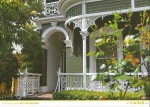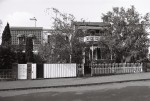The Opera House
East Melbourne, Powlett Street 138
Auction brochure for auction of 138 Powlett Street, East Melbourne scheduled for 1 April 2017. Colour photos. Plans
The house sold for $4,150,000
- 2347 reads
East Melbourne, Powlett Street 138, 140, 142
On the left of the photo is a pair of houses numbered 140-142 Powlett Street, East Melbourne. The facade of No 140 has been covered in the once fashionable concrete breeze blocks, since restored. On the right is 138 Powlett Street, known as The Opera House because of its unusual curved balcony.
- 2006 reads
East Melbourne, Powlett Street 138, The Opera House
A two storey house with a basement level in addition. It has an unusual verandah and balcony which have given rise to it being known as The Opera House. The City of Melbourne Heritage site says, "The balcony is of an unknown date but is believed to be later than 1868.
George Alfred Badger was an architect and built the house for himself. His other architectural work includes grandstands and booths at Flemington, Caulfield, Geelong and Kilmore race tracks and work for the Public Works Department at Parliament House. He never lived in the house and sold it in 1878.


